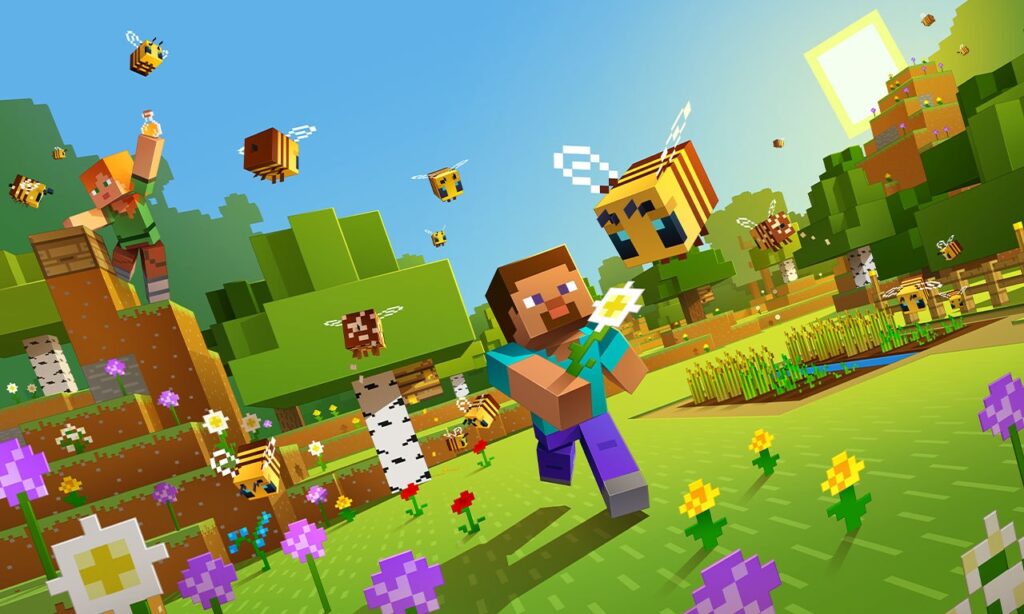
Players try not to get stung as they follow Vanilla Buzzy Bees to locate their nest and harvest Minecraft honey, which can be used to craft a number of useful items. The Minecraft universe is a place where creativity knows no bounds, filled with monsters and treasures. (Courtesy of Mojang/Microsoft)
The mental health crisis among children and adolescents is one of the most urgent challenges the United States is facing today. According to the U.S. Centers for Disease Control and Prevention, one in five children experiences mental health issues such as anxiety, depression, or behavioral disorders, yet most never receive the care they need. As rates of mental health struggles increase — fueled by the impact of social isolation, academic stress, and digital overload — finding innovative solutions has become more important than ever.
While traditional therapy is vital, we must rethink how we engage today’s young people, who spend much of their time in the digital world. Video games, in particular, have long been viewed with skepticism for their potential negative impacts. However, emerging research reveals that video games can actually be powerful therapeutic tools, offering new ways to help young people develop emotional and social skills and improve their cognitive performance.
Recent studies suggest games requiring problem-solving, teamwork, and emotional regulation mirror many of the goals of traditional therapy. These games can teach children how to cope with frustration, collaborate effectively, and build confidence — skills that are foundational to emotional wellbeing. By integrating video games into therapeutic settings, we can tap into an activity many children already love, using it as a bridge to develop life skills in a fun and engaging way.
Thrive Behavioral Health embraces this approach through an innovative gaming group program launched in September 2023 that uses popular platforms like PlayStation and Nintendo Switch to foster social and emotional development. Sessions, built around games such as Minecraft, Cuphead, Super Smash Bros., Untitled Goose Game, and Astro Playroom, help children ages 8 to 18, learn patience, mindfulness, and teamwork. Kids collaborate in pairs, small groups and sometimes large groups to build virtual environments, learning valuable communication and problem-solving skills in the process. We have access to a catalog of over 150 games, spanning from 1986 to the present, allowing us to target different therapeutic outcomes and engage the children’s developmental goals and interests.
By integrating video games into therapeutic settings, we can tap into an activity many children already love, using it as a bridge to develop life skills in a fun and engaging way.
While there is understandable concern about screen time and gaming addiction, structured programs like the one offered by Thrive can also teach children how to use technology responsibly. By incorporating lessons on internet safety and healthy boundaries, we can ensure that children are equipped to navigate the digital world while using these tools for personal growth. We have several safeguards in place, including tailored parental controls and therapeutic supervision throughout gameplay to ensure a safe, positive, and focused environment for the children. A therapist actively engages with the children throughout gameplay to guide conversations, provide real-time feedback, and model appropriate behaviors.
However, the success of programs like these is contingent on having enough trained professionals to lead them. The shortage of mental health practitioners, particularly those trained to work with children and adolescents, remains a critical issue. We need more mental health providers who are skilled not only in traditional therapies but also in innovative, tech-driven approaches to treatment.
The path forward is clear: To address the youth mental health crisis, we must meet children where they are — often in front of screens — and create engaging, interactive therapeutic experiences that resonate with their digital lives. At the same time, expanding the mental health workforce is essential to ensure that these innovations can reach the children who need them most.
By embracing technology and equipping professionals to harness its potential, we can create a brighter, healthier future for today’s youth, one that prioritizes both mental wellbeing and responsible technology use. The digital world is here to stay — let’s use it as a tool for healing and growth.
GET THE MORNING HEADLINES.

